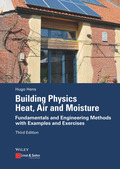Building Physics: Heat, Air and Moisture
Fundamentals and Engineering Methods with Examples and Exercises

3. Edition September 2017
348 Pages, Softcover
112 Pictures (55 Colored Figures)
63 tables
Textbook
Short Description
Building physics combines heat and mass transfer, building acoustics, lighting, and indoor air quality, and has a true impact on energy performance and serviceability. This volume focuses on heat, air, moisture transfer and its usage in engineering applications. With examples.
Buy now
Price: 69,00 €
Price incl. VAT, excl. Shipping
Euro prices for Wiley-VCH and Ernst & Sohn titles are only valid for Germany. In EU countries, local VAT applies. Postage will be charged.
- Out of print -
Note: The 4th edition of this book has been published in September 2023.
Bad experiences with construction quality, the energy crises of 1973 and 1979, complaints about "sick buildings", thermal, acoustical, visual and olfactory discomfort, the need for good air quality, the move towards more sustainability - all these have accelerated the development of a field that, for a long time, was hardly more than an academic exercise: building physics (in English speaking countries sometimes referred to as building science). The discipline embraces domains such as heat and mass transfer, building acoustics, lighting, indoor environmental quality and energy efficiency. In some countries, fire safety is also included. Through the application of physical knowledge and its combination with information coming from other disciplines, the field helps to understand the physical phenomena governing building parts, building envelope, whole buildings and built environment performance, although for the last the wording "urban physics" is used. Today, building physics has become a key player on the road to a performance based building design.
The book deals with the description, analysis and modeling of heat, air and moisture transport in building assemblies and whole buildings with main emphasis on the building engineering applications, including examples. The physical transport processes determine the performance of the building envelope and may influence the serviceability of the structure and the whole building.
Compared to the second edition, in this third edition the text has partially been revised and extended.
0.1 Subject of the book
0.2 Building physics
0.3 Importance
0.4 History
0.5 Units
0.6 Symbols
1 Heat transfer
1.1 Overview
1.2 Conduction
1.2.1 Conservation of energy
1.2.2 The conduction laws
1.2.3 Steady state
1.2.4 Transient
1.3 Heat exchange at surfaces
1.4 Convection
1.4.1 In general
1.4.2 Typology
1.4.3 Quantifying the concevtive surface film coefficient
1.4.4 Values for the convective surface film coefficient
1.5 Radiation
1.5.1 In general
1.5.2 Definitions
1.5.3 Reflection, absorption and transmission
1.5.4 Radiant bodies
1.5.5 Simple Formulae
1.6 Building-related applications
1.6.1 Surface film coefficients and reference temperatures
1.6.2 Steady state: flat assemblies
1.6.3 Local inside surface film coefficients
1.6.4 Steady state: two and three dimensions
1.6.5 Heat balances
1.6.6 Transient
1.7 Problems and solutions
2 Mass Transfer
2.1 Generalities
2.1.1 Quantities and definitions
2.1.2 Saturation degrees
2.1.3 Air and moisture transfer
2.1.4 Moisture sources
2.1.5 Air and moisture in relation to durability
2.1.6 Link to energy transfer
2.1.7 Conservation of mass
2.2 Air
2.2.1 Overview
2.2.2 Air pressure differentials
2.2.3 Air permeances
2.2.4 Airflow in open-porous materials
2.2.5 Airflow across assemblies with air-open layers, leaky joints, leaks and cavities
2.2.6 Air transfer at the building level
2.2.7 Combined heat and air flow in open-porous materials
2.3 Vapour Transfer
2.3.1 Water vapour in the air
2.3.2 Water vapour in open-porous materials
2.3.3 Vapour transfer in the air
2.3.4 Vapour flow by diffusion in open-porous materials and assemblies
2.3.5 Vapour flow by diffusion and convection in open-porous materials and assemblies
2.3.6 Surface film coefficients for diffusion
2.3.7 The surface film coefficient for diffusion applied
2.4 Moisture
2.4.1 Overview
2.4.2 Water flow in a pore
2.4.3 Vapour flow in a pore that contains water isles
2.4.4 Moisture flow in a pore that contains water isles
2.4.5 Moisture flow in materials and assemblies
2.4.6 Simplified moisture flow model
2.5 Problems and solutions
3 Combined Heat, Air and Moisture Flow
3.1 Introduction
3.2 Material and assembly level
3.3 Whole building level
3.4 Problems and solutions
Postscript


